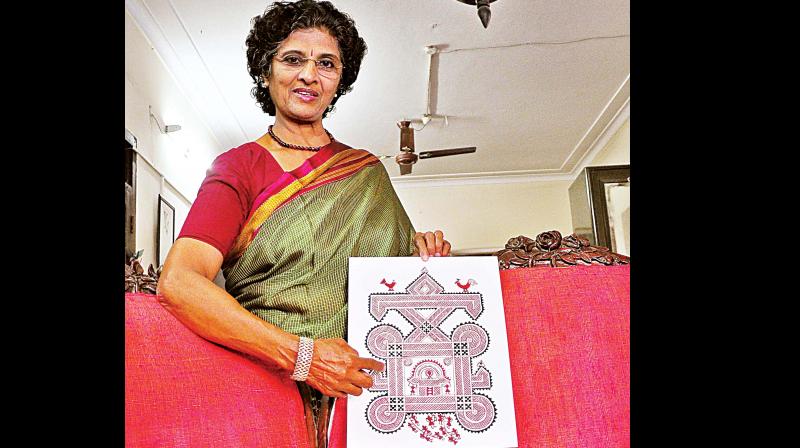Chittara: Geeta Bhat will not let this ancient art die

Geeta Bhat reminds one of an aunt in the family who pushes you to pursue your goals, helps you every step of the way and is always ready to reassure you that no dream is too far-fetched. She has dedicated her life to reviving Chittara, a near- extinct fresco tradition done exclusively by women in the villages in and around the city of Sagara in Karnataka.
It's been a difficult journey and her eyes bear evidence of this, but with great passion comes great suffering, which she has borne with aplomb. The mere mention of her beloved Chittara is enough to make her glow. "I have always been fascinated by folk art and culture," said Geeta, who works toward giving these local artists a mainstream platform that will empower them to make a living and also keep an ancient, indigenous art tradition alive. Her journey began when she stumbled upon Chittara work at an exhibition in Chitrakala Parishath. "I was completely amazed by it," she said. "When I dug deeper, I learned that it was unique to this particular community. The more I found out about it, the more it interested me," she said.
The women she worked with might have been uneducated in the conventional sense of the term, but possessed an unparalleled artistic sensitivity. Research took about two years, during which she travelled back and forth between Bengaluru and the state's rural heartland, where the artists live. Chittara, she explained, is done only by the womenfolk, who use all natural colours (which they make themselves) and work only by night. "They go out to work in the fields during the day and return in the evenings. There is no electricity in these places so they use candles to work," she said.
Hand painted, with intricate geometric motifs, the fresco tradition depicts whatever the artist sees in nature. While there are about approximately 15 kinds of chittara depictions, the most common are the ones painted during wedding ceremonies. Traditionally painted by the women of the Deevaru community of Karnataka on the walls of their houses, the depictions differ from artist to artist. “The basic structure remains the same. It shows the walls of the house, symbols showing birds that denote love and protection called goodina hakki, symbolic hands of different gods, instrumentalists in a wedding or people attending the ceremony and the bride and groom in the middle of the image," she explained. Their use of colour is bold and vibrant - reds, yellows, black and white dominate the work because colours are derived from natural substances from their immediate surroundings," Geeta points out. Their paint brushes are also made with natural fiber.
Geeta, with the support of her friends, put her research into the form of a paper which was published in the National Society for Education in Art and Design. That gave her the first opportunity to present to the world the wonder that was Chittara, becoming the first Indian to do so on an international platform. She went on to accomplish another first: an exhibition of chittara paintings in Holland in 2008, where two artists from the community showcased their work. She coached a team of 18 design students and along with two chittara artists, created a massive mural in IGNCA, which she says was a major step forward. "It was 15 feet by 10 feet approximately. There were 20 of us and it was completely chittara work. What really touched me and felt like progress was the fact that the students came back later with a presentation that had incorporated the fresco in their designs. Awareness, appreciation, impetus, that is what matters," she said."
She now helps the community women market their work on a mainstream platform. "Earlier, they did it to express their emotions, decorate their houses, but with the influence of western culture and the concept of nucleated families seeping into their lives, the younger ones aren't willing to take it up. That's why it's important to spread awareness - a monetary incentive always helps," she added.
She hopes that the coming year will bring with it more positive results to her tireless efforts. "We hope to organize more workshops to promote chittara to institutes that could use the knowledge and adapt it in their own way, like NIFT, NID, architecture institutes and we would really like to do more murals. I hope 2017 will be our year," she says, smiling hopefully.

